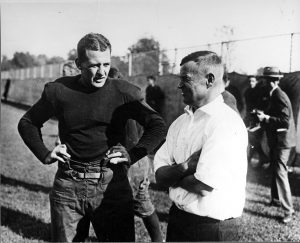Previous Sports Tour Stop | Return to Sports Tour Map | Next Sports Tour Stop
While students sitting in Block I watch the University of Illinois football team play on Zuppke Field in Memorial Stadium, few of them know anything about the man for whom the field is named or how he shaped the game they watch.
From 1913 until 1941, Robert Zuppke served as the head coach of the University of Illinois football team. Coach Zuppke introduced and standardized plays and formations football teams continue to use. During loud games, Zuppke noticed backfield players gathering together to share play calls. Zuppke took this trend a step further by having the entire team gather together in a huddle to discuss the next play. Today, spectators see huddles in everything from youth football games to the National Football League’s Super Bowl.

Even though almost all football teams now use huddles, teams draw upon some of Zuppke’s other innovations less frequently. For example, scholars credit Zuppke for creating the trick play known as the “flea flicker.” By having multiple players throw the ball in a single play, flea flickers confuse defenses but require talented players for proper execution. Thankfully, Zuppke had the legendary Harold “Red” Grange on his team to run the flea flicker.
In three years of playing football at the University of Illinois under Coach Zuppke, Red Grange scored 31 touchdowns in 20 games. Grange and Zuppke remained close over the years. After dominating college football and legitimizing professional football, Red Grange eventually wrote a book titled Zuppke of Illinois. In the preface to this book, Grange wrote “Robert Zuppke made me in football.” A year later, Grange sent Zuppke a personal telegram asserting “you are still the greatest coach in football.”

Many of Zuppke’s former players shared this attitude. In letters sent back to the coach they affectionately called “Zupp,” people such as George Halas asked for advice about football and life.
Among his players and peers, Zuppke became well known for his “Zuppke-isms” and “Zuppke Maxims.” Some related directly to football and others connected football to Zuppke’s other great love: art. In one quote, Zuppke suggested that “a football player, like any good artist, must learn to express himself with alert abandonment.” To Zuppke, painting and football went hand in hand.
After resigning from coaching in 1944, Zuppke continued painting and talking about football from his farm near Mahomet. Until the end of his life, Zuppke sent and received correspondence with plays scribbled in the margins. Although Zuppke loved football, he recognized learning as “the great central theme of university life.”
Whether we remember Zuppke while watching a game in Memorial Stadium, which Zuppke helped tremendously to raise funds for, or walking through Krannert Art Museum, we can consider how innovations in football and art spur learning forward in Champaign-Urbana and beyond.
Trivia Question:
In 1944, Zuppke named his pet __________ after former player Red Grange.
-
- Parakeet
- Shetland Pony
- German Shepherd
- Maine Coon Cat
3. German Shepherd
- Memorial Stadium
Hoddeson, L. (2004). No boundaries: University of Illinois vignettes. University of Illinois Press.
Materials from the University of Illinois Archives, Record Series 28/3/20 Robert Zuppke Papers include
Box 1 Folders 1931 and Zuppgrams and Zuppke Maxims.
Grange, H.E. (1938). Telegram from Red Grange to Robert Zuppke. Box 1.
Grange, H.E. (1937). Zuppke of Illinois. A.L. Glaser, inc. Box 8
Images:
Lloyde, D.H. (1912). Coach Robert Zuppke. Photograph Album, 1900-1914. Record Series 39/2/24, Box 1, Folder 101-210, Number 146
U of I Office of Public Information. (1920). Coach Robert Zuppke head shot. Photographic Subject File, 1868-. Record Series 39/2/20, Folder FAC-4.
(1925). Grange and Zuppke (1). Photographic Subject File, 1868-. Record Series 39/2/20, Box ATH-2, Folder ATH 2-3 REd GRange, 1924-1929.
